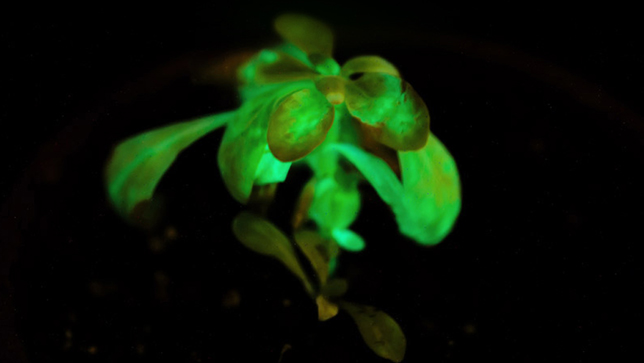Glowing trees could be used "instead of street lighting" says Daan Roosegaarde
Dezeen and MINI Frontiers: Dutch designer Daan Roosegaarde is exploring ways of using bio-luminescent bacteria found in jellyfish and mushrooms to create glow-in-the-dark trees that could replace street lights.

In this movie filmed at SXSW in Austin, Roosegaarde explains how: "In the last year I really became fond of biomimicry."
"What can we learn from nature and apply to the built environment, to roads, to public spaces, to our urban landscape?" asks Roosegaarde.
Biomimicry is the method of imitating models and systems found in nature to solve complex design issues. One of the biological phenomena that fascinated Roosegaarde was how animals like jellyfish and fireflies generate their own light.

"When a jellyfish is deep, deep underwater it creates its own light," he says. "It does not have a battery or a solar panel or an energy bill. It does it completely autonomously. What can we learn from that?"
Roosegaarde's interest in biomimicry led him to collaborate with the State University of New York and Alexander Krichevsky, whose technology firm Bioglow unveiled genetically modified glow-in-the-dark plants earlier this year.
Subscribe to Dezeen's YouTube channel for the latest architecture and design movies
Krichevsky creates the glowing plants by splicing DNA from luminescent marine bacteria to the chloroplast genome of a common houseplant, so the stem and leaves emit a faint light similar to that produced by fireflies and jellyfish.
Roosegaarde is now working on a proposal to use a collection of these plants for a large-scale installation designed to look like a light-emitting tree.

He had just taken delivery of one of the small Bioglow houseplants when he met up with Dezeen in Austin.
"This one was shipped to my hotel room and I’m really excited to have it in my hand," he says, holding the small plastic box that contains the plant. "This is a very small version that we have produced. Right now we are teaming up with [the University of New York and Krichevsky] to create a really big one of them like a tree instead of street lighting."
"I mean, come on, it will be incredibly fascinating to have these energy-neutral but at the same time incredibly poetic landscapes."

Strict regulations around the use of genetically modified plants within the EU mean that Roosegaarde cannot use this material in his Netherlands studio. He had to travel to the US to receive the plant.
Distinct from Studio Roosegaarde's work with Krichevsky is a second project exploring bio-luminescence, called Glowing Nature, which does not use genetically-modified material. The aim was to find a means of giving mature trees light-emitting properties without harming them, building on research into the properties of bio-luminescent mushrooms.

The proposal is to use a very fine coating of "biological paint" that when applied to trees allows them to glow at night. The coating charges during the day and at night can glow for up to eight hours. Trials using the material will start at the end of this year.
The music featured in the movie is a track by Zequals. You can listen to his music on Dezeen Music Project.
Dezeen and MINI Frontiers is a year-long collaboration with MINI exploring how design and technology are coming together to shape the future.

